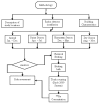Assessment of indoor radon distribution and seasonal variation within the Kpando Municipality of Volta Region, Ghana
- PMID: 38412163
- PMCID: PMC10898764
- DOI: 10.1371/journal.pone.0299072
Assessment of indoor radon distribution and seasonal variation within the Kpando Municipality of Volta Region, Ghana
Abstract
This study uses CR-39 radon detectors to examine radon distributions, seasonal indoor radon variations, correction factors, and the influence of building materials and characteristics on indoor radon concentration in 120 dwellings. The study also determines the spatial distribution of radon levels using the ArcGIS geostatistical method. Radon detectors were exposed in bedrooms from April to July (RS), August to November (DS); December to March (HS), and January-December (YS) from 2021 to 2022. The result for the radon levels during the weather seasons were; 32.3 to 190.1 Bqm-3 (80.9 ± 3.2 Bq/m3) for (RS), 30.8 to 151.4 Bqm-3 (68.5 ± 2.7 Bqm-3) for HS and 24.8 to 112.9 Bqm-3(61.7 ± 2.1 Bqm-3) for DS, and 25.2 to 145.2 Bq/m3 (69.4 ± 2.7 Bqm-3). The arithmetic mean for April to July season was greater than August to November. The correction factors associated with this study ranged from 0.9 to 1.2. The annual effective dose (AE) associated with radon data was varied from 0.6 to 4.04 mSv/y (1.8 ± 0.1 mSv/y). The April to July period which was characterized by rains recorded the highest correlation coefficient and indoor radon concentration. Distribution and radon mapping revealed radon that the exposure to the occupant is non-uniformly spread across the studied dwellings. 15.4% of the studied data exceeded WHO reference values of 100 Bq/m3. The seasonal variation, dwelling age, and building materials were observed to have a substantial impact on the levels of radon concentration within the buildings.
Copyright: © 2024 Amable et al. This is an open access article distributed under the terms of the Creative Commons Attribution License, which permits unrestricted use, distribution, and reproduction in any medium, provided the original author and source are credited.
Conflict of interest statement
The authors have declared that no competing interests exist.
Figures
Similar articles
-
INDOOR RADON CONCENTRATION AND RISK ASSESSMENT IN SOME DWELLINGS OF OBUASI, MINING TOWN.Radiat Prot Dosimetry. 2020 Jun 12;188(1):30-37. doi: 10.1093/rpd/ncz254. Radiat Prot Dosimetry. 2020. PMID: 31711205
-
Assessment of Seasonal Radon Concentration in Dwellings and Soils in Selected Areas in Ga East, Greater Accra Region of Ghana.J Environ Public Health. 2022 Aug 24;2022:6600919. doi: 10.1155/2022/6600919. eCollection 2022. J Environ Public Health. 2022. PMID: 36060873 Free PMC article.
-
Indoor radon levels in primary schools of Patras, Greece.Radiat Prot Dosimetry. 2007;124(2):172-6. doi: 10.1093/rpd/ncm180. Epub 2007 May 17. Radiat Prot Dosimetry. 2007. PMID: 17513290
-
Indoor radon concentrations in Adana, Turkey.Radiat Prot Dosimetry. 2008;131(2):259-64. doi: 10.1093/rpd/ncn157. Epub 2008 May 10. Radiat Prot Dosimetry. 2008. PMID: 18469346
-
Indoor exposure levels of radon in dwellings, schools, and offices in China from 2000 to 2020: A systematic review.Indoor Air. 2022 Jan;32(1):e12920. doi: 10.1111/ina.12920. Epub 2021 Aug 25. Indoor Air. 2022. PMID: 34432341
References
-
- United Nations Scientific Committee on the Effects of Atomic Radiation. Sources and Effects of Ionizing Radiation, United Nations Scientific Committee on the Effects of Atomic Radiation (UNSCEAR) 2000 Report, Volume I: Report to the General Assembly, with Scientific Annexes-Sources. United Nations; 2000 Oct 13.
-
- World Health Organization. WHO handbook on indoor radon: a public health perspective. World Health Organization; 2009. - PubMed
-
- Yazzie SA, Davis S, Seixas N, Yost MG. Assessing the impact of housing features and environmental factors on home indoor radon concentration levels on the Navajo nation. International Journal of Environmental Research and Public Health. 2020. Apr;17(8):2813. doi: 10.3390/ijerph17082813 - DOI - PMC - PubMed
-
- Reste J, Pavlovska I, Martinsone Z, Romans A, Martinsone I, Vanadzins I. Indoor Air Radon Concentration in Premises of Public Companies and Workplaces in Latvia. International Journal of Environmental Research and Public Health. 2022. Feb 10;19(4):1993. doi: 10.3390/ijerph19041993 - DOI - PMC - PubMed
MeSH terms
Substances
LinkOut - more resources
Full Text Sources
Medical
Miscellaneous












